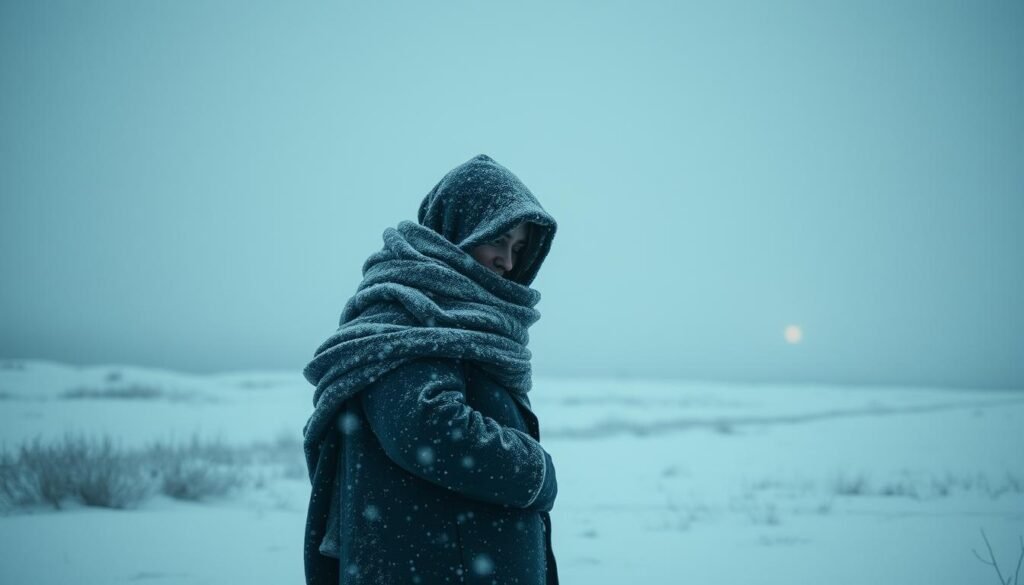Did you know up to 20% of people feel chronically tired in winter? This is known as cold fatigue. It makes folks feel constantly tired, making simple tasks hard. Especially with the extra effort to stay warm. When it gets cold, our bodies have a hard time adjusting. This leads to a lack of energy, affecting what we do every day and how sharp our minds are.
We’ll go deep into cold fatigue here, showing its signs and how it’s different from hypothermia. We’ll explore what causes this type of tiredness in the winter. Plus, we’ll talk about ways to fight this tired feeling. Knowing about cold fatigue can help folks feel more energized, even when it’s very cold. If tiredness sticks around too long, getting advice from a doctor is key. Read this informative article for more tips.
Key Takeaways
- Cold fatigue affects up to 20% of the population during winter.
- Underactive thyroid glands can lead to feelings of cold and fatigue.
- Factors such as sleep deprivation and emotional stress exacerbate winter tiredness.
- Dietary changes can significantly alleviate symptoms of anemia-related fatigue.
- Seeking medical attention is crucial if fatigue persists for over two weeks.
- Regular physical activity can help combat chilly climate lethargy.
- Massage therapy may aid in relaxation and support better sleep patterns.
Understanding Cold Fatigue
Cold fatigue is when you feel very tired because of cold weather. Your body has to work harder to keep warm when it’s cold. This makes you use more energy. Because of this, you might feel more tired both in your body and mind. Research shows that being cold can make it harder for your body to use oxygen and for your muscles to work well. This can make you feel tired all the time.
In winter, you might notice you’re feeling tired more often. This could be worse if you also get a cold or another sickness. The CDC says it usually takes about a week to get over a common cold. Symptoms are worst in the first few days. This makes it hard to tell if it’s just the cold or also the cold weather making you tired.
It’s important to know how cold weather affects your energy. If you’re often in cold places, you might need to find ways to feel more awake and warm. Knowing the signs of cold fatigue helps you keep your energy up. It also makes the cold less uncomfortable.
Signs and Symptoms of Cold Fatigue
Cold fatigue affects daily life and well-being in many ways. Spotting the signs early helps manage it better. It’s important to know how cold weather tiredness appears for timely help.
Low Energy Levels
People with cold fatigue often feel very tired. Even easy tasks seem hard to do. This low energy makes people less active, which makes things worse.
Drowsiness and Sleepiness
Drowsiness and wanting to sleep a lot are key symptoms. People feel like napping all day, even if they slept well at night. This affects work and social life, leading to isolation.
Brain Fog and Difficulty Concentrating
Cold fatigue also impacts the mind. Many feel a foggy brain, finding it hard to think or decide. It’s tough to stay focused, which is frustrating.
To deal with these symptoms, a broad strategy is needed. Adding stress management can help. Looking into dietary changes and other tips at https://brightnboost.com/natural-remedies-for-adrenal-fatigue-treatment/ can offer more help and ways to recover.
Comparing Cold Fatigue with Hypothermia Symptoms
Cold fatigue and hypothermia symptoms can be confusing because both relate to the cold. Knowing the difference between them is crucial for responding correctly when it’s cold. While they both result from cold conditions, their impact and seriousness are not the same.
Key Differences to Note
Cold fatigue shows up as ongoing tiredness and a lack of energy. It causes slight discomfort but isn’t a dire situation. On the other hand, hypothermia begins when your body temperature goes below 95°F (35°C).
Symptoms of hypothermia include severe shaking, confusion, tiredness, and a notably low body temperature. This is an urgent health issue.
| Aspect | Cold Fatigue | Hypothermia Symptoms |
|---|---|---|
| Core Body Temperature | Normal | Below 95°F (35°C) |
| Primary Symptoms | Tiredness, lethargy | Extreme shivering, confusion, difficulty walking |
| Severity | Mild | Severe, requires immediate medical attention |
| Response Needed | Rest and warmth | Seek medical intervention |
When to Seek Medical Attention
It’s vital to know when hypothermia is happening. If extreme shivering, confusion, or low alertness occur after being in the cold, get medical help right away. Older adults and people with health problems are more likely to get very sick from hypothermia, even in milder cold. Paying attention to these signs can help avoid serious health issues.
Causes of Cold Fatigue
Understanding why we get tired when it’s cold is key, especially in chilly places. Many things cause this tired feeling, the main one being how our bodies react to cold. When we’re exposed to cold for too long, our bodies struggle to make energy. This makes us feel more tired. Plus, some health issues get worse in the cold, so it’s important to know these reasons.
The Impact of Low Body Temperature
Having a low body temperature often makes us feel very cold, leading to what’s called *chilly climate lethargy*. Some health problems make us feel colder. For example:
- Anemia makes people tired and cold, often with pale skin and a fast heartbeat.
- Hypothyroidism can make you chilly, tired, and cause weight gain.
- Blood vessel issues can make your hands and feet cold, turning fingers and toes blue.
- Lacking Vitamin B12 might make you cold, weak, and numb.
Effects of Cold Weather on Physical Condition
Cold weather makes some health problems worse, which adds to feeling tired. People with low BMI might feel colder because they lack body fat, leading to low blood pressure and tiredness. Pregnant people can also feel colder, which might be due to not eating enough calories or anemia. Staying hydrated is harder in winter, making the fatigue worse. Below is a table with conditions that make cold feel more intense:
| Condition | Symptoms |
|---|---|
| Anemia | Fatigue, paleness, fast heartbeat |
| Hypothyroidism | Fatigue, weight gain, cold sensitivity |
| Diabetic Nephropathy | Cold sensations, nausea, swelling |
| Low BMI | Tiredness, low blood pressure, muscle issues |
| Vitamin B12 Deficiency | Coldness, weakness, numbness |
Knowing these factors helps us deal with cold fatigue better. By being aware, we can work on feeling better overall.

Winter Tiredness: Factors That Contribute
Winter has unique challenges that often cause winter tiredness for many people. These include seasonal changes and psychological effects seen in the colder months. Understanding these factors can help people recognize and manage their winter tiredness better.
Role of Seasonal Changes
Less daylight and reduced sunlight are key factors behind increased winter fatigue. The shift to daylight savings time also messes with our internal clocks. This adjustment can take weeks and makes us feel more sleepy.
Additionally, when it gets colder, our melatonin levels go up, making us tired. Cold temps can also slow our metabolism and drop our energy. Plus, eating more comfort food and less exercise in winter can make us feel sluggish.
Psychological Effects of Winter Months
The winter season doesn’t just tire our bodies—it affects our minds. Seasonal affective disorder (SAD) is common and hits harder in places with little daylight. It’s more common in women and can lead to depression and anxiety.
About 3 in 100 people experience serious winter depression because of SAD. This adds to the challenge of fighting winter tiredness, highlighting the need to understand both its physical and mental impacts.
Cold Fatigue: Strategies for Combatting Tiredness
Cold fatigue can really affect your energy, especially when it’s cold outside. Luckily, you can do things to fight off this tired feeling. Staying warm and eating right are key to beating cold fatigue.
Staying Warm: Dressing for the Chilly Climate
Dressing in layers is key to keeping the cold at bay. Thermal clothes keep you warm, and adding gloves, hats, and scarves helps a lot. Here’s more advice:
- Choose moisture-wicking fabrics to stay dry while keeping warm.
- Opt for insulated outer layers to shield against wind and cold.
- Keep the living space adequately insulated to minimize drafts.
- Maintain an ambient temperature between 60 and 67 degrees Fahrenheit for optimal rest.
Diet and Nutrition Tips
A good diet is your friend in fighting cold fatigue. Eat foods that warm you up and give you energy. Follow these food tips:
- Consume hearty soups, such as chicken soup, to help reduce inflammation and promote comfort.
- Include foods rich in Vitamin D to counteract deficiencies commonly seen in winter months.
- Stay hydrated to prevent fatigue and maintain fluid balance; this supports overall well-being.
- Aim for regular meals to stabilize energy throughout the day.
Using these strategies can help you fight cold fatigue and enjoy winter. Dressing warmly and eating well are great defenses against the cold.
Physical Activity to Combat Cold Fatigue
Engaging in regular physical activity is a strong way to fight cold fatigue. It boosts energy levels and mood. This helps resist the psychological effects of the cold. Adding movement into your day, like outdoor runs or indoor exercises, helps reduce tiredness in cold months.
Benefits of Regular Exercise
Regular exercise has many benefits against cold fatigue. The American College of Sports Medicine (ACSM) and the Centers for Disease Control and Prevention (CDC) recommend at least 150 minutes of moderate exercise weekly. That’s around 22 minutes a day. They also recommend two days of strength training every week for energy and muscle health.
- Boosts hormone levels like serotonin, contributing to higher energy.
- Improves overall mood and can help alleviate symptoms of anxiety.
- Aids in enhancing sleep quality, which is crucial during periods of cold fatigue.
Indoor Activities to Boost Energy
Indoor activities are key in winter. Yoga, dancing, and aerobics offer warm ways to stay active. Yoga, for example, lessens fatigue and boosts mental focus. Fitness trackers promote joining online step challenges with loved ones for fun and support.
If you’re unsure about exercising outside, knowing what to wear helps. Dressing in layers keeps you warm and comfortable. Always prioritize safety, especially with cold weather and health concerns now.
| Exercise Type | Duration | Benefits |
|---|---|---|
| Aerobic | 150 minutes/week | Enhances cardiovascular health, boosts mood |
| Strength Training | 2 sessions/week | Preserves muscle mass, increases strength |
| Yoga | 30 minutes/session | Relieves stress, improves flexibility |
| Dance | 30 minutes/session | Promotes cardiovascular fitness, is fun |
Mental Health and Cold Weather Exhaustion
The link between mental health and cold fatigue is clear in winter. Seasonal Affective Disorder (SAD) majorly impacts many people’s mental state. This happens as sunlight decreases, making the body produce more melatonin. This leads to feelings of extreme tiredness and lack of interest in daily things.
Understanding Seasonal Affective Disorder (SAD)
Millions in the U.S., especially in places like Alaska or New England, face SAD. It’s more common in women and starts in young adulthood. If you have family with depression or bipolar disorder, you might be more at risk. Symptoms include feeling very tired, depressed, and unmotivated. This can make winter’s cold feel even colder. For more on this, check out this article about winter fatigue and SAD.
Ways to Manage Mental Health During Winter
There are effective ways to handle the emotional strain of winter. Light therapy is a great treatment for SAD. Cognitive Behavioral Therapy (CBT) is also good, working as well as light therapy. Getting natural light is key. It ups your vitamin D, keeping your mood and energy up.
Sticking to a daily routine with time outside helps your body’s clock. This fights off tiredness. If you keep feeling down or very tired, seeing a doctor is important. They can help you feel better.

Frosty Environment Burnout: Identifying the Problem
Frosty environment burnout is when you feel very tired because you’re in the cold too much. It happens when the cold drains your body and mind for a long time. You might not notice at first, but over time, the cold makes you lose your energy.
It’s important to know if you’re getting cold fatigue. Look for signs like:
- Decreased motivation to do everyday things.
- Increased levels of irritability because you’re uncomfortable and tired.
- Difficulty concentrating because you’re mentally exhausted.
The environment plays a big part in causing frosty burnout. Getting less sun in the winter lowers your vitamin D. This makes you feel more tired. Feeling lonely because it’s too cold to go out also makes things worse. Staying inside a lot means you move less. This affects how happy and healthy you feel.
Keeping warm takes a lot of energy too. Wearing lots of clothes or heating your home makes you even more tired. This creates a tough cycle of tiredness that’s hard to escape from.
To deal with cold fatigue, you need to understand these problems. Know your own limits and find ways to stay well when it’s cold. Taking good care of yourself is key. It helps you keep up your energy and fight the negative impact of the cold.
Preventive Measures Against Cold Fatigue
Taking steps ahead of time can reduce cold fatigue effects. By adopting smart habits, people can keep their energy up in winter. Key actions include getting enough sleep and staying well-hydrated.
Establishing a Healthy Sleep Routine
A regular sleep pattern is crucial for fighting cold fatigue. Resting well lets the body heal from the chill. Aim for 7 to 9 hours of sleep each night.
Try relaxing methods like meditation or gentle stretching before bed. These can improve your sleep quality.
Hydration and Its Importance
It’s important to drink enough fluids, especially when it’s cold. Not drinking enough can make you feel more tired. Focus on water, herbal teas, and broths to keep up your fluid intake.
This helps your body work well and fights off the cold. Always having a water bottle close by is a good reminder to drink throughout the day.

| Preventive Measure | Description | Benefits |
|---|---|---|
| Healthy Sleep Routine | Maintain a consistent sleep schedule. | Improves energy levels and helps combat cold fatigue. |
| Hydration | Drink plenty of fluids daily. | Prevents dehydration and reduces freezing temperature weakness. |
Conclusion
Many people struggle with cold fatigue in winter, feeling tired, low in energy, and mentally foggy. Knowing the symptoms and causes helps manage health in winter. It’s crucial to know how things like cytokines and viral infections impact us.
To fight cold fatigue, staying warm, eating well, and staying active are key. These steps not only reduce symptoms but also make winter better. By looking into research on common cold effects, people can better handle these challenges.
Cold fatigue can also affect work and increase healthcare costs. So, it’s vital to use personal strategies to fight this fatigue during winter. Addressing cold fatigue can change our winter experience for the better.